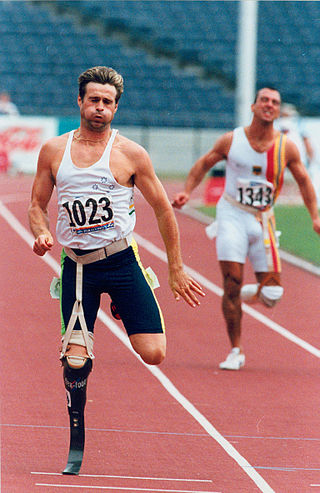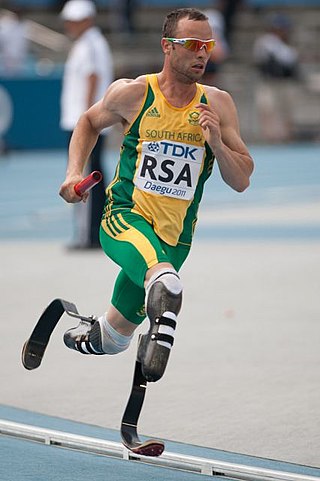Related Research Articles

In medicine, a prosthesis, or a prosthetic implant, is an artificial device that replaces a missing body part, which may be lost through trauma, disease, or a condition present at birth. Prostheses are intended to restore the normal functions of the missing body part. Amputee rehabilitation is primarily coordinated by a physiatrist as part of an inter-disciplinary team consisting of physiatrists, prosthetists, nurses, physical therapists, and occupational therapists. Prostheses can be created by hand or with computer-aided design (CAD), a software interface that helps creators design and analyze the creation with computer-generated 2-D and 3-D graphics as well as analysis and optimization tools.
A pegleg is a prosthesis, or artificial limb, fitted to the remaining stump of a human leg. Its use dates to antiquity.

Oscar Leonard Carl Pistorius is a South African former professional sprinter and convicted murderer. Both of his feet were amputated when he was 11 months old owing to a congenital defect; he was born missing the outside of both feet and both fibulae. Pistorius ran in both nondisabled sprint events and in sprint events for below-knee amputees. He was the 10th athlete to compete at both the Paralympic Games and Olympic Games.
James Foort was a Canadian inventor, artist, and innovator in the field of prosthetic limbs.
Therdchai Jivacate is a Thai orthopedic surgeon and inventor known for his humanitarian activities in providing free prosthetic limbs to impoverished amputees, and for his development of techniques allowing low-cost, high-quality prostheses to be made from local materials. The activities of the Prostheses Foundation, which he founded in 1992 under royal sponsorship from the Princess Mother Srinagarindra, have expanded beyond the borders of Thailand to Malaysia, Laos, and Burma. Jivacate has established Thailand's first and only educational institution of occupational therapy at Chiang Mai University. He has also created an educational programme for children suffering from chronic diseases at Maharaj Hospital in Nakhon Ratchasima. In 2008, he was given the Ramon Magsaysay Award for Public Service.
Össur hf. is a company based in Iceland that develops, manufactures and sells non-invasive equipment for orthopaedics, including bracing and support products, compression therapy, and prosthetics. The company is headquartered in Reykjavík, with offices in the Americas, Europe, and Asia, and distributors in other markets.
Hanger, Inc. is a leading national provider of products and services that assist in enhancing or restoring the physical capabilities of patients with disabilities or injuries that is headquartered in Austin, Texas. The company provides orthotic and prosthetic (O&P) services, distributes O&P devices and components, manages O&P networks, and provides therapeutic solutions to patients and businesses in acute, post-acute, and clinical settings. Hanger, Inc. operates through two segments: Patient Care and Products & Services.

Orthotics is a medical specialty that focuses on the design and application of orthoses, or braces. An orthosis is "an externally applied device used to influence the structural and functional characteristics of the neuromuscular and skeletal system".
T42 is a disability sport classification for disability athletics, applying to athletes with single above the knee amputations or a disability that is comparable. This class includes ISOD classified A2 and A9 competitors.
T43 is a disability sport classification for disability athletics, applying to athletes with "Double below knee amputation or similar disability." It includes ISOD classified athletes from the A4 and A9 classes.

T44 is a disability sport classification for disability athletics, applying to "Single below knee amputation or an athlete who can walk with moderately reduced function in one or both legs." It includes ISOD A4 and A9 classes.
Kevin Carroll is an Irish prosthetist, researcher, educator, and author. He is the Vice-President of Prosthetics for Hanger Clinic, a prosthetics and orthotics provider in the United States.

The Flex-Foot Cheetah is a prosthetic human foot replacement developed by biomedical engineer Van Phillips, who had lost a leg below the knee at age 21; the deficiencies of existing prostheses led him to invent this new prosthesis.

The mechanics of the running blades used by South African former Paralympic runner Oscar Pistorius depend on special carbon-fiber-reinforced polymer prosthetics. Pistorius has double below-the-knee amputations and competed in both non-disabled and T44 amputee athletics events. Pistorius's eligibility to run in international non-disabled events is sanctioned by the International Association of Athletics Federations (IAAF).
Amputee sports classification is a disability specific sport classification used for disability sports to facilitate fair competition among people with different types of amputations. This classification was set up by International Sports Organization for the Disabled (ISOD), and is currently managed by IWAS who ISOD merged with in 2005. Several sports have sport specific governing bodies managing classification for amputee sportspeople.
A2 is an amputee sport classification used by the International Sports Organization for the Disabled (ISOD).for people with acquired or congenital amputations. A2 sportspeople have one leg amputated above the knee. Their amputations impact their sport performance, including having balance issues, increased energy costs, higher rates of oxygen consumption, and issues with their gait.
A3 is an amputee sport classification used by the International Sports Organization for the Disabled (ISOD) for people with acquired or congenital amputations. A3 classified sportspeople have both legs amputated below knee. Their amputations impact their sport performance, including having balance issues, increased energy costs, higher rates of oxygen consumption, and issues with their gait. Sports people in this class are eligible to participate in include athletics, swimming, sitting volleyball, archery, weightlifting, badminton, lawn bowls, sitzball and wheelchair basketball.
A4 is an amputee sport classification used by the International Sports Organization for the Disabled (ISOD).for people with acquired or congenital amputations. People in this class have one leg amputated below the knee. Their amputations impact their sport performance, including having balance issues, increased energy costs, higher rates of oxygen consumption, and issues with their gait. Sports people in this class are eligible to participate in include athletics, swimming, sitting volleyball, archery, weightlifting, wheelchair basketball, amputee basketball, amputee football, lawn bowls, and sitzball.

Gait deviations are nominally referred to as any variation of standard human gait, typically manifesting as a coping mechanism in response to an anatomical impairment. Lower-limb amputees are unable to maintain the characteristic walking patterns of an able-bodied individual due to the removal of some portion of the impaired leg. Without the anatomical structure and neuromechanical control of the removed leg segment, amputees must use alternative compensatory strategies to walk efficiently. Prosthetic limbs provide support to the user and more advanced models attempt to mimic the function of the missing anatomy, including biomechanically controlled ankle and knee joints. However, amputees still display quantifiable differences in many measures of ambulation when compared to able-bodied individuals. Several common observations are whole-body movements, slower and wider steps, shorter strides, and increased sway.

Margarethe Caroline Eichler was a German inventor, instrument maker and prostheses designer. She was the first woman in Prussia to receive a patent and was also the inventor of the first practical modern hand prosthesis.
References
- ↑ "Runaway Success". European Patent Office . Retrieved 2015-02-12.
- 1 2 3 "Inventor of the Week, January 2007: Van Phillips". Lemelson-MIT program. Archived from the original on 2007-07-14. Retrieved 2008-07-02.
- 1 2 3 4 Martha Davidson. "Artificial Parts: Van Phillips". Smithsonian Institution . Retrieved 2008-07-02.
- ↑ Pogash, Carol (2008-07-02). "A Personal Call to a Prosthetic Invention". New York Times . Retrieved 2008-07-02.